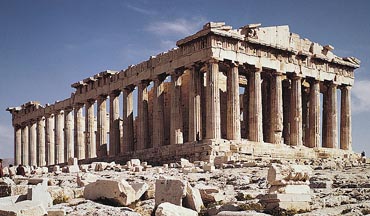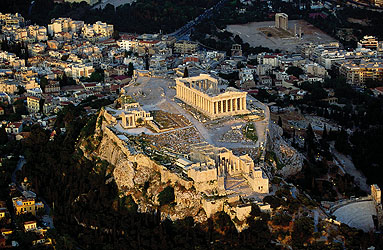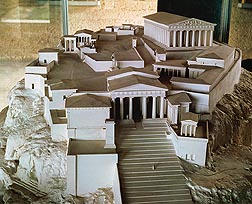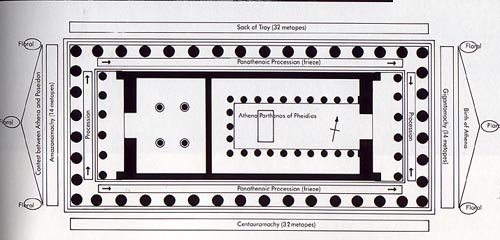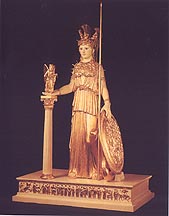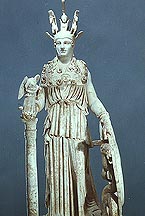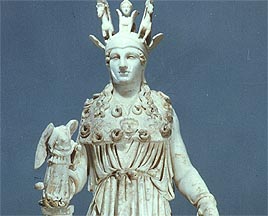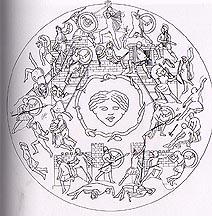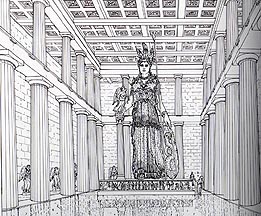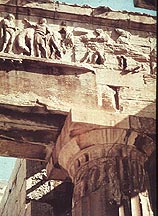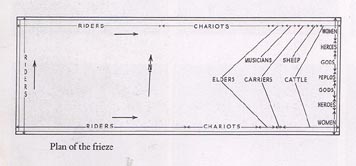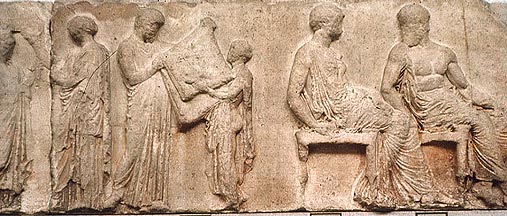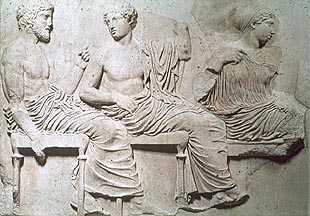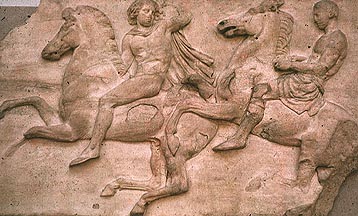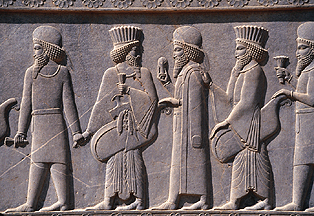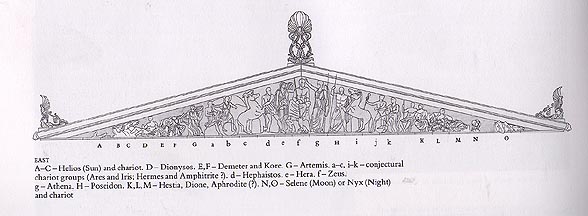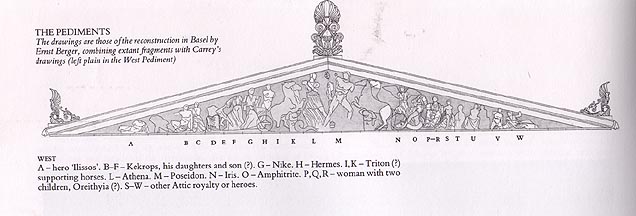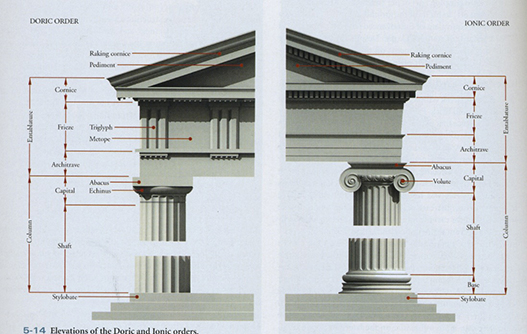Art Home | ARTH Courses | ARTH 200 Assignments
The Parthenon: Religion, Art, and Politics
Central to the American Constitution is the separation of Church and State. This principle was a direct response of the dangers the Founding Fathers saw in the mixing of religion and politics in European culture. Religious and political orders were closely intertwined in the Western tradition. Going back to Ancient Greece of the Classical period, one sees the close relationship between religion and politics.
Historians have long noted that the evidence for the creation of the first temples to house religious cults occurred at the same time as the foundations of the first Greek city-states, the essential political unit in the Greek world. City-states fostered the local cult practices because they were a crucial way of defining the community. Religious festivals and sacrifices were open to members of the community, and by participating and sharing in the celebrations, citizens validated their memberships in the community.
The location of the temple in a city was also a way of linking the building to the past. This is well demonstrated by the Parthenon. The Parthenon is located on a hill known as the Acropolis, or "High City." Archaeologists have demonstrated that during the second millenium the Acropolis had been the site of a Mycenaean citadel. Athenian myths associated the Acropolis also as the site of the competition between Athena and Poseidon for hegemony over Athens. Athenians legends also associate the Acropolis with the founding of the city.[Add reference to Erechtonius] During the Archaic period major temples were constructed on the Acropolis.
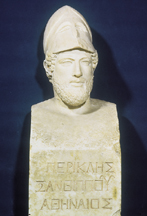 It
was very intentional on the part of the Persians that during their occupation
of Athens in 480 BCE they sacked the buildings on the Acropolis. This was
to the Athenians like taking their hearts out. The Greeks revenge this defeat
by destroying the Persian navy in the battle of Salamis. Subsequently the
Persians were forced to retreat to Asia. After the defeat of the Persians,
Athens emerged as the most dominant Greek city- state. The Athenian statesman
of the middle of the fifth century BCE, Pericles clearly saw the value of
a major building campaign in giving physical testimony to Athenian power and
prestige among the other Greek city-states and their confidence in being able
to withstand any future invasion from Persia.
It
was very intentional on the part of the Persians that during their occupation
of Athens in 480 BCE they sacked the buildings on the Acropolis. This was
to the Athenians like taking their hearts out. The Greeks revenge this defeat
by destroying the Persian navy in the battle of Salamis. Subsequently the
Persians were forced to retreat to Asia. After the defeat of the Persians,
Athens emerged as the most dominant Greek city- state. The Athenian statesman
of the middle of the fifth century BCE, Pericles clearly saw the value of
a major building campaign in giving physical testimony to Athenian power and
prestige among the other Greek city-states and their confidence in being able
to withstand any future invasion from Persia.
This political context is crucial in understanding the Parthenon, the centerpiece of the Periclean building campaign.
The Sculptural Program of the Parthenon
Sculpture had long been integrated into the architecture of Greek temples, but the Parthenon is exceptional in the amount of sculptural decoration and the clear coordination of the different elements into a coherent sculptural program. As a demonstration of the extensive of the sculptural program all 92 metopes in the Doric frieze course have sculptured reliefs [for architectural terms see the glossary at the end of this webpage].
The Athena Parthenos
The centerpiece of the sculptural programme of the Parthenon was the monumental statue of Athena in the main cella of the temple. The statue was a chryselephantine statue made of gold and ivory, and was approximately 38 feet tall. Although no longer extant, Ancient copies and literary descriptions have allowed scholars to produce fairly accurate reconstructions. The one above is from the Royal Ontario Museum in Toronto.
Athena as the warrior maiden is a perfect embodiment of Athens. The combination of male/female and strength/beauty in the statue is a characterization of Athens itself. Athena was understood as the protector and champion of the city and as the giver of the urban arts and handicrafts especially spinning and weaving. As seen in the Parthenon statue, Athena was regularly represented as wearing military garb including a helmet, breastplate, spear, and shield. This brings out her warrior identity. The statue and the Parthenon as a whole are clearly monuments to Athena's gifts of the urban arts. This is well echoed in the following passage from Plutarch's account of the Periclean building campaign included in the Life of Pericles:
| The materials to be used were stone, bronze, ivory, gold, ebony, and cypress-wood; the arts which should elaborate and work up these materials were those of carpenter, moulder, bronze-smith, stone-cutter, dyer, worker in gold and ivory, painter, embroiderer, embosser, to say nothing of the forwarders and furnishers of the material, such as factors, sailors and pilots by sea.... |
Consideration of elements that form the statue clearly echo the political meaning of the work. Athena holds in her right hand a Nike figure, or Winged Victory, to commemorate the Greek victory over the Persians. Her helmet bears images of a sphinx in the center and griffins on either side. The eastern origin of these monsters would probably not have been lost on the Athenian observer, who would have made the identification of the monsters to Persia. On the upper-chest of Athena appears an aegis on which appears a gorgoneion (head of Medusa) in the center. The inclusion of these "monsters" plays an apotropaic function of warding off evil, but these figures also echo the Greek subjugation of the monstrous. This is especially true of the gorgoneion. It was Athena who helped Perseus defeat Medusa. Perseus, one of the great Athenian heroes, gave the severed head of Medusa to Athena in thanks.
The snake that appears on the inside of Athena's shield is a reference to mythical origins of Athens. The snake was understood as a representation of Erichthonius who was the off-spring of Hephaestus and Ge, or Earth. He was thus understood as a reference back to the aboriginal origins of Athens, and to the time before the Olympian God's triumph over the Giants, the off-spring of Ge. Ericthonius's aboriginal nature is suggested by his snake form. According the myth, Ge entrusted Ericthonius in the care of Athena. The serpent was contained in a box, and Athena, in turn, gave the box to the three daughters of Cecrops with the explicit instructions that the box should not be opened. The daughters did not obey, and when they saw the monstrous shape, they were driven crazy and jumped off the Acropolis. The inclusion of the snake had rich meaning for the Athenians. On one level, that Ericthonius was the off-spring of Ge, was a demonstration of the autocthonous nature of the original Athenians as being original inhabitants of the land. To be an Athenian one had to have parents that both come from families that were Athenian citizens. So an Athenian citizen would see himself [sic since only males could be citizens] as an off-spring of Ericthonius. That Athena was given responsibility of looking after Ericthonius who was placed in a box was understood as part of the succession myth where the Olympian Gods overcome the off-spring of Ge and bring them into order. The disobedience of the daughters of Cecrops and their punishments would have been understood as references to the folly of women and the patriarchal structure of Athenian society.
Images of conflict also appear on other details of the work. According to ancient literary descriptions, the Athena's sandles bore representations of the battle between the Lapiths and centaurs (Centauromachy), while the inside of the shield was apparently painted with images of the battles of the Gods and Giants (Gigantomachy). Literary descriptions and copies have modern archaeologists to reconstruct the outside of the shield which represented the conflict between Greeks and Amazons (Amazonomachy):
The Centauromachy, Amazonomachy, and the Gigantomachy were repeated along with the addition of the Battle of Greeks and Trojans (the Iliouspersis) in the metopes on the exterior of the Parthenon. All of these scenes reiterate the common theme of the Greeks overcoming the other. In the case of the Gigantomachy, it is the story of the victory of the Olympian Gods over giants who are the offspring of Ge and Ouranos --earth and sky. This is the subject of Hesiod's Theogony- one of the earliest works from Greek literature. This is the archetype of all the other conflict scenes. They all echo the victory of order (cosmos) over chaos, civilization over barbarism developed in webpage dedicated to Greek and the Other.
It is striking from a modern perspective to note that though the Parthenon was constructed in clear response to the Greek victories over the Persian, there are no direct representations of these victories on the Parthenon. Though not directly represented, the defeat of the Persians finds echoes in the conflict scenes. For example, the Amazons were female warriors who come from the east like the Persians, and the Troy's location on the boundary between the Greek world and Persia would have clearly been understood to be a parallel to the victory of the Greeks over the Persians. This approach to subject matter reflects a general characteristic of Greek art and reflects what we observed in our discussion of the Greek attitude towards portraiture. Rather than show the particular, the Greek represents the archetype. Contemporary events were read from the perspective of Greek myth and legend.
The relief on the base of the Athena Parthenos was the creation of Pandora, the first woman. According to Hesiod, Pandora was born in two stages: Hephaestus first molded her from clay and then Athena dressed and adorned her. While man only the single stage to be created, woman's nature needed the second stage of being adorned. Understand this in relationship to the nude kouroi versus the clothed korai figures. Hesiod (lines 585-602) describes how Pandora once she is adorned is brought out by Zeus to an assembly of gods and mortals who marvel at her ((ll. 585-589) But when he had made the beautiful evil to be the price for the blessing, he brought her out, delighting in the finery which the bright-eyed daughter of a mighty father had given her, to the place where the other gods and men were. And wonder took hold of the deathless gods and mortal men when they saw that which was sheer guile, not to be withstood by men.(ll. 590-602) For from her is the race of women and female kind: of her is the deadly race and tribe of women who live amongst mortal men to their great trouble, no helpmeets in hateful poverty, but only in wealth.)
.
In our mind's eye we can at least develop a mental picture of what the Athena Parthenos statue might have looked like. We know that a shallow pool of water was placed on the floor before the statue. The water was there to protect the ivory from cracking, but imagine the visual effect of seeing the gold and ivory stature towering above you and lit by torches and indirect light. All of this reflecting in the pool of water before it. Clearly the sight would have been sumptuous. This was undoubtedly intended to be a statement of Athenian supremacy, but this undoubtedly offended many non-Athenian Greeks who prided themselves of living moderately. Plutarch records this response in his Life of Pericles:
| And surely Hellas is insulted with a dire insult and manifestly subjected to tyranny when she sees that, with her own enforced contributions for the war, we are gilding and bedizening our city, which, for all the world like a wanton woman, adds to her wardrobe precious stones and costly statues and temples worth their millions.” |
The Ionic Frieze: The Panathenaic Procession
One of the most remarkable features of the sculptural program of the Parthenon is the inclusion of continuous relief representing a central event in Athenian social and religious life: the Panathenaic Procession. Religious festivals played an important role in defining a community. While solemn religious sacrifices were important, competition in sports, poetry, drama, etc. were a central part of religious festivals. This competitive or what the Greeks understood as agonistic nature of social life we have seen as central theme in the Parthenon.
The Panathenaic Festival, or "All Athens Festival," was celebrated every year and in a grander way every four years. The festival was in celebration of the mythical birth of Athena. The culminating event of the Grand Panathenaic festival celebrated every four year was the Panathenaic Procession. Beginning outside the walls of the city, the procession would wind its way through the city, pass many of the important civic spots, and mount the Acropolis. The culminating moment of the procession would be the dressing of the cult statue of Athena (not the Athena Parthenos) with a new peplos or robe decorated with a gigantomachy and woven by a select group of maidens.
The frieze on the Parthenon which extends some 525 feet (160 meters) long represents a variety of phases of the procession. It begins on the southwest corner of the temple with scenes of riders preparing to mount their horses, and then extends to the north on the west side and then moves from west to east on the north and south sides. For a sampling of details from the frieze see the webpage entitled Parthenon: Gallery of Images. The cycle culminates on the east end of the temple by a scene showing a young woman offering a folded cloth to a priest. This images is flanked by a group of seated Gods and Goddesses:
While there is little question that the frieze represents the Panathenaic Procession, scholars debate about the specific nature. Aspects of the frieze are inconsistent with descriptions of the fifth century celebration. Some have seen this as the first celebration conducted by the mythical founders of Athens, others have associated it with the heroized warriors who had died in the battle of Marathon, and still others have seen it as a generic representation of the recurring procession.
As a recurring ritual in the civic life of Athens, the Panathenaic Procession was an important way an Athenian citizen would understand their identity. It is interesting to look at the relief as an image of Athenian citizenship. The frieze focuses on the Athenian males. The only women, except for the goddesses on the east end, are the group of maidens. The males included cover a range of age from young men to the elders. Note that there are no older women included in the frieze. This is another testament to the patriarchal nature of the Athenian society. Women, after all, were not considered citizens. Citizenship was open to only Athenian born males.
The frieze is a striking demonstration of the Athenian artists' mastery of the representation of the human figure. No two figures in the work are identical with the artists capturing the rich variety of human movement. Figures are shown turning in space and from a variety of points of view. An interesting comparison can be made by juxtaposing a detail from the Panathenaic Procession from the nearly contemporary procession decorating the Persian citadel in Persepolis (c. 521-465 BCE).
While no two figures are identical on the Parthenon frieze, it is again striking to note the absence of any sense of individual identity in the figures. The artists again focus on types for example the youthful beardless male as opposed to the bearded elder. The procession thus represents all Athenian citizens and not particular ones. The frieze just like the procession itself thus establishes Athenian civic identity.
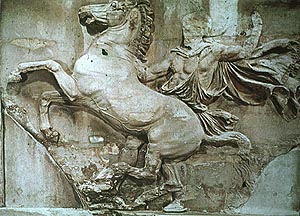 Details
of the procession like the one of the rider taming the wild, rearing horse
echo the common theme of the temple of cosmos over chaos, human over animal.
The bulging veins and wild expression of the horse clearly bring out its chaotic
nature. The detail makes an interesting comparison to the famous chorus from
Sophocles tragedy Antigone:
Details
of the procession like the one of the rider taming the wild, rearing horse
echo the common theme of the temple of cosmos over chaos, human over animal.
The bulging veins and wild expression of the horse clearly bring out its chaotic
nature. The detail makes an interesting comparison to the famous chorus from
Sophocles tragedy Antigone:
[332] Wonders are many, and none is more wonderful than man. [335] This power spans the sea, even when it surges white before the gales of the south-wind, and makes a path under swells that threaten to engulf him. Earth, too, the eldest of the gods, the immortal, the unwearied, [340] he wears away to his own ends, turning the soil with the offspring of horses as the plows weave to and fro year after year. [343] The light-hearted tribe of birds [345] and the clans of wild beasts and the sea-brood of the deep he snares in the meshes of his twisted nets, and he leads them captive, very-skilled man. He masters by his arts [350] the beast who dwells in the wilds and roams the hills. He tames the shaggy-maned horse, putting the yoke upon its neck, and tames the tireless mountain bull. [354] Speech and thought fast as the [355] wind and the moods that give order to a city he has taught himself, and how to flee the arrows of the inhospitable frost under clear skies and the arrows of the storming rain. [360] He has resource for everything. Lacking resource in nothing he strides towards what must come. From Death alone he shall procure no escape, but from baffling diseases he has devised flights. [365] Possessing resourceful skill, a subtlety beyond expectation he moves now to evil, now to good. When he honors the laws of the land and the justice of the gods to which he is bound by oath, [370] his city prospers. But banned from his city is he who, thanks to his rashness, couples with disgrace. Never may he share my home, [375] never think my thoughts, who does these things!
The Pediments
The subject matter of the east pediment is the birth of Athena when Hephaestus strikes the head of Zeus and out of his head comes Athena fully formed. The subject is appropriate since it corresponds to the culmination of the Panathenaic Procession which occurred on the birthday of Athena. Note how the donation of the peplos at the center of the east side of the procession is surrounded by a group of gods and goddesses echoes the gods and goddesses flanking the birth of Athena on the east pediment. The east end is also given more privilege by the appearance of the battle of the Gods and Giants in the metopes.
The west pediment presents another conflict or agonistic scene with Athena combatting Poseidon for the patronage of Athens. Both pediments emphasize the superiority of Athena, and thus by implication the superiority of Athens among the other Greek city-states.
Related websites:
The Parthenon: a Gallery of Images
Texts pertaining to the Parthenon
The Greeks: the Crucible of Civilization: a PBS show focusing on Classical Greece and Athens in particular. The page entitled The Acropolis Experience includes QTVR reconstructions of the Acropolis and the Parthenon. The one entitled "How the Parthenon was Built" includes a reconstruction of the interior of the Parthenon with the Athena Parthenos.
Preliminary Bibliography of Secondary Sources:
John Boardman and David Finn, The Parthenon and its Sculpture.
John Boardman, Greek Sculpture: The Classical Period,
pp. 90-145.
Paul Cartledge, "The Greek Religious Festivals," in Greek Religion and Society, P.E. Easterling and J.V. Muir eds., pp.
98-127.
David Castriota, Myth, Ethos and Actuality: Official Art
in Fifth-Century Athens, University of Wisconsin, 1992, especially pp.
134-229.
William Bell Dinsmoor, The Architecture of Ancient Greece,
pp. 159-178.
Simon Hornblower, "Greece: The History of the Classical
Period," in The Oxford History of the Classical World, pp. 124-141.
Jeffrey M. Hurwit, The Art and Culture of Early Greece, 1100-480
B.C., pp. 234-253 (for the early history of the Acropolis).
Jennifer Neils ed., Goddess and Polis: The Panathenaic Festival in Ancient Athens, Princeton, 1992. (Available in the Hartwick Library).
J.J. Pollitt, Art and Experience in Classical Greece,
pp. 64-110.
Martin Robertson, A Shorter History of Greek Art, pp. 90-106.
Terms:
areté: bravery, courage, personal excellence; later moral virtue.
hybris (hubris): arrogance, insolence, violence, injury, rape.
sophrosyné: self-restraint engendered by self-knowledge.
Athena Promachos or Polias: Athena a protector and champion of the city, and as the patroness of the urban arts and handicrafts.
Athena Nike: Athena of victory.
Athena Parthenos: Athena as warrior maiden.
Greek Orders and Parts of the Temple
Cella (or naos)- the main chamber of a Greek or Roman
temple, built to house the cult statue.
Peristyle- the colonnade around a peripteral building or around a court.
Peripteral- a adjective describing a building with a colonnade around
its entire perimeter.
Intercolumniation- the space between two adjacent columns.
Stereobate- a solid mass of masonry serving as the visible base of
a building, especially a Greek temple. In a Greek temple only the lower steps
are called the stereobate; the top step, on which the columns rest, is called
the stylobate.
Entasis- the swelling convex curvature along the line of taper of classical
columns. The entasis of early Greek Doric columns is pronounced, but becomes
ever more subtle until, in the columns of the Parthenon, it is barely perceptible.
Echinus- in the Doric order, the quarter round molding beneath the
abacus of a capital.
Abacus- the uppermost part of a capital, forming a slab upon which
the architrave rests.
Entablature- the group of horizontal member resting on the columns
of the one of the classical orders. It is divided into three parts: architrave,
frieze, and cornice.
Architrave- the lowest member of an entablature, resting directly on
the columns.
Frieze- the middle member of an entablature, between the architrave
and cornice.
Triglyph- in the frieze of the entablature of the Doric order, the
vertical blocks, which are divided by channels into three sections. Originally,
the triglyphs were probably the ends of wooden ceiling beams.
Metope- in the frieze of an entablature of the Doric order, one of
the panels between the triglyphs, sometimes ornamented. Originally, in wooden
temple, the metopes may have been openings between the ceiling beams.
Cornice- the topmost part of a classical entablature.
Pediment- in classical architecture, the low-pitched gable, or triangular
area formed by the two slopes of the low-pitched roof of a temple, framed
by the horizontal and raking cornices and sometimes filled with sculpture.
Orders- an architectural "order" is one of the classical
systems of carefully proportioned and interdependent parts which include
column
and entablature.
Doric- the oldest, studiest, and most severe of the orders. It developed
on the mainland of Greece. The most distinguishing characteristic is probably
its capital, but note the absence of a column base and the introduction of
triglyphs and metopes in the frieze course.
Ionic- is more slender and lighter than the Doric. The Ionic developed
in the lands east of the Aegean and was more subject to the influence of older
Asiatic styles. It is quickly distinguished by the volutes of its capitals.
Note the presence of a column base and the absence of the triglyphs and metopes.
Corinthian- developed later than the Doric or Ionic. It is distinguished
from the Ionic by its capital formed of a circular belle of rows of acanthus
leaves.
